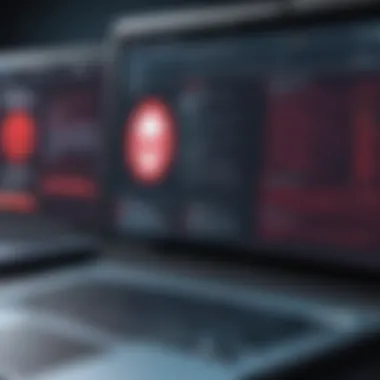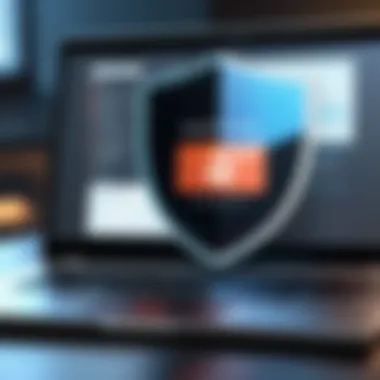Malware Protection for Laptops: A Comprehensive Guide


Intro
In an age where laptops function as pivotal tools for both personal and professional tasks, ensuring their protection against malware has become paramount. Malware poses significant threats, infiltrating systems to steal sensitive information, compromise data integrity, and disrupt operations. This guide serves to shed light on the multifaceted world of malware protection specifically tailored for laptop users.
Understanding the nuances of various types of malware is crucial. Viruses, worms, Trojans, and ransomware each have distinct behaviors and impacts. For instance, while viruses attach themselves to legitimate files, worms propagate independently, spreading across networks without user intervention. Equipped with knowledge about these threats, users can better prepare themselves against potential attacks.
The relevance of this topic cannot be overstated. As the sophistication of malware continues to evolve, so too must our defenses. This guide is designed to equip readers with actionable strategies, preventive measures, and tools available to enhance their laptop security. Emphasizing user awareness and best practices will bolster the defense against the ever-changing landscape of malware threats.
Understanding Malware
Understanding malware is crucial for anyone using laptops, including IT professionals and business owners. Knowing what malware is, the different types, and how it can infiltrate systems is the first step in protecting devices. Ultimately, awareness equips users with the necessary tools to avoid falling victim to attacks.
Definition of Malware
Malware, short for malicious software, refers to any software deliberately designed to cause harm to a computer system. This can include software that disrupts operations, steals sensitive data or gains unauthorized access to systems. It is essential to comprehend that malware is a broad term that encompasses various threats targeting laptops and other devices.
Types of Malware
Malware can manifest in many forms, each with distinct characteristics and implications for laptop users.
Viruses
Viruses are one of the oldest forms of malware. They attach themselves to clean files and spread through user activities like downloads or email attachments. A notable characteristic of viruses is their ability to self-replicate, which helps them to proliferate quickly. This type of malware can corrupt or delete files and often requires a user to execute the infected program. Their potential for damage makes them a significant threat in this discussion.
Worms
Worms have similar destructive capabilities but differ in their method of spread. Unlike viruses, they do not require a host file to propagate. Instead, worms exploit network vulnerabilities to move from one device to another. This self-sufficient energy makes them particularly dangerous, as they can spread rapidly without user intervention. Worms often consume substantial bandwidth and compromise network performance.
Trojans
Trojans are particularly insidious, as they masquerade as legitimate software. Users are often tricked into downloading Trojans, leading to a breach of security. Once installed, they can create backdoors, allowing attackers unauthorized access to systems. The deceptive nature of Trojans underscores their importance in this article. They put users’ data and devices at risk without them realizing it.
Ransomware
Ransomware is a severe threat where attackers encrypt a user’s data and demand a ransom for the decryption key. Its key characteristic is its targeted aim to profit from users’ desperation. The impact is often devastating, as individuals and businesses may lose crucial information. This type of malware has gained notoriety in recent years, emphasizing the need for robust protection strategies.
Spyware
Spyware secretly collects information from users without their knowledge. It can track web browsing habits, collect login credentials, and even monitor keystrokes, leading to significant privacy concerns. The capacity of spyware to operate invisibly makes it a formidable threat. Users often remain unaware of the ongoing data collection, placing their personal and financial information at risk.
Adware
Adware displays unwanted advertisements and can redirect users to unwanted websites. While not always considered malicious, it can lead to a poor user experience and may include spyware functionalities. Some users welcome adware since it can be bundled with software for free in exchange for viewing ads. However, the potential for invasive data tracking and loss of browsing privacy cannot be neglected.
Common Sources of Malware Attacks
Understanding common sources of malware provides insight into how to better protect laptops.
Infected Downloads
Infected downloads are a frequent entry point for malware. Users may unknowingly download malicious software disguised as legitimate files. This is particularly harmful when downloading software from unofficial sites. Users must be cautious and ensure that they are obtaining files from reputable sources to avoid these risks.
Phishing Emails
Phishing emails are crafted to trick users into revealing sensitive information. They often appear to be from trusted sources, making them difficult to spot. Educating users on how to identify suspicious emails is vital. Many malware attacks originate from users clicking links or downloading attachments from these deceptive messages.
Unsecured Networks
Using unsecured networks can expose laptops to malware attacks. Public Wi-Fi networks lack encryption, making it easy for attackers to intercept data. Users should be aware of the dangers of connecting to open networks, especially when handling sensitive information. Employing a virtual private network (VPN) can help secure connections, but vigilance is still needed when accessing these networks.
The Importance of Malware Protection


Malware protection is essential for maintaining the integrity of laptops and safeguarding sensitive information. In this digital age, where data is crucial for both personal and professional activities, understanding the implications of malware is vital. Protecting against these threats not only ensures the security of personal data but also enhances the overall performance and longevity of the device. Moreover, the growing sophistication of cyber attacks necessitates a proactive approach to malware protection.
Impact of Malware on Laptops
The effects of malware on laptops can be substantial, significantly affecting users’ functionality and experience.
Data Loss
Data loss is perhaps the most distressing outcome of a malware attack. Important files, documents, and personal data can be irretrievably lost, impacting both work and leisure activities. The destructive nature of some malware can lead to complete file destruction or encryption, rendering data useless. This highlights the necessity of reliable backup solutions. Those who prioritize data security can minimize risks associated with loss. Basic prevention measures can save a lot of trouble later.
Privacy Breaches
Privacy breaches are another serious concern for laptop users. Malware can steal sensitive information such as usernames, passwords, and financial details without the user’s consent. This unauthorized access can lead to identity theft or other forms of cyber exploitation. The rise in privacy concerns has made it crucial for users to understand preventive measures. Establishing strong security practices can help mitigate these risks effectively, making it an invaluable aspect of malware protection strategies.
Financial Consequences
The financial consequences of malware are often overlooked but can be significant. Organizations and individuals may incur costs related to data recovery, system repairs, and potential legal fees. In some cases, if sensitive client data is exposed, the fallout can lead to hefty fines and sanctions. Understanding this aspect of malware can shape effective security strategies that protect not only data but also finances. Long-term financial planning should always include contingencies for such incidents.
Long-Term Implications
The ramifications of malware incidents extend beyond immediate threats, affecting long-term stability and reputation.
Reputation Damage
Reputation damage can occur as a result of malware. Once a breach happens, trust can be eroded, particularly for businesses. Consumers often choose brands based on reliability and security. A single incident can tarnish a company’s image significantly and result in long-term loss of clientele. Addressing these issues proactively can enhance customer loyalty and assurance about security practices.
Operational Disruption
Operational disruption from malware attacks can lead to downtime and hinder business processes. Employees may be unable to access critical resources, affecting productivity and efficiency. Such interruptions can disrupt normal business activities for extended periods, resulting in lost revenue. Assessing vulnerabilities and investing in protective measures can prevent such disruptions, ensuring a smoother operational flow.
Understanding the importance of malware protection is crucial for all laptop users in today’s digital landscape. Proactive measures play a vital role in safeguarding data and maintaining operational stability.
Preventing Malware Infection
Preventing malware infection is a crucial aspect of maintaining your laptop's security. As malware evolves, so do the methods used to infiltrate systems. By taking proactive measures, users can significantly reduce the likelihood of a successful attack. The essence of this section is to explore strategies that not only thwart such infections but also fortify the user’s overall cybersecurity posture.
Regular Software Updates
Updating software regularly serves as a fundamental defense against malware attacks. Software developers frequently release updates to fix known vulnerabilities. Failure to install these updates leaves laptops exposed to threats. Users should enable automatic updates whenever possible.
When an update is available, it often contains patches that resolve security flaws that attackers might exploit. Ignoring these updates could have severe repercussions. Therefore, it's wise to schedule a time to check for updates consistently. This can ensure that all applications and operating systems remain secure and up to date.
Utilizing Antivirus Software
Antivirus software is essential for any laptop user concerned about malware protection. It acts as the first line of defense against malware. While free solutions exist, paid options typically offer more comprehensive features, including real-time scanning, automatic updates, and customer support.
When selecting antivirus software, consider important features such as:
- Real-time protection
- Regular updates for virus definitions
- Scanning capabilities (full, quick, and custom scans)
- Additional functions like anti-phishing and firewall integration
Each of these features contributes significantly to a robust protective environment. Choosing the right program can mean the difference between smooth operation and a malware crisis.
Avoiding Suspicious Links and Downloads
A common method for malware infiltration is through clicks on suspicious links or untrusted downloads. It is prudent to approach emails, messages, and websites with caution. Phishing attempts often lure users into clicking on malicious links disguised as legitimate ones. By following safe browsing practices, users can minimize risks.
Some key strategies include:
- Avoid clicking on links in unsolicited emails.
- Double-check URLs to ensure they lead to reputable sites.
- Be skeptical of downloads from poorly rated or unknown sources.
- Use link-checker tools to verify safety before accessing them.
These practices can greatly reduce the risk of inadvertently enabling malware on one’s device.


Using a Firewall
The implementation of a firewall is an essential step in mitigating the risk of malware attacks. A firewall acts as a barrier between a laptop and potential threats. It monitors incoming and outgoing network traffic, allowing only legitimate data while blocking harmful elements.
Users can choose between hardware firewalls and software firewalls. Here are some considerations for each:
- Hardware Firewalls: These are typically integrated into routers. They provide a secure network environment but may require technical knowledge to configure effectively.
- Software Firewalls: These are installed on individual computers and offer more customizable security options.
Configuring a firewall to block unwanted traffic is vital for maintaining a secure laptop environment.
Essential Tools for Malware Protection
When it comes to protecting laptops from malware, having the right tools is essential. The landscape of digital threats is constantly evolving, which makes it crucial for users to stay equipped with effective solutions. Utilizing essential tools not only enhances security but also provides peace of mind to users, knowing they have resources to combat potential threats. Each type of tool serves a unique purpose, covering various aspects of malware protection. By understanding the available options and what features to look for, individuals and organizations can proactively safeguard their devices and data.
Antivirus Software Options
Free vs. Paid Solutions
The choice between free and paid antivirus solutions plays a significant role in malware protection. Free antivirus programs can offer essential basic protection against common threats. However, their effectiveness may vary, and some might lack features that are essential for comprehensive security. Paid solutions typically offer advanced protection, regular updates, and customer support. Their key characteristic lies in the continual development of features that adapt to newer threats, making them a more robust choice for serious users.
A unique feature of many paid antivirus programs is the inclusion of real-time scanning, which provides broader coverage against threats as they emerge. While free options can be a good starting point for users, they often fall short in providing the level of security required for professional and intensive use. Therefore, understanding the specific needs and choosing the right type of solution becomes vital.
Features to Look For
Identifying necessary features in antivirus software is critical. Key characteristics such as malware detection capability, user interface, and customer reviews can impact decisions. Effective malware protection will often include options like scheduled scans, web protection, and email scanning. Stability and user-friendliness are other important aspects that enhance user experience.
Another unique feature to consider is behavior-based detection. This allows the antivirus to identify suspicious behavior in applications rather than relying solely on signature databases. This can provide a layer of security against unknown threats. Failing to pay attention to these features may lead to vulnerabilities, underscoring the importance of careful research before making a selection.
Anti-Malware Tools
Comparison of Popular Tools
When selecting anti-malware tools, comparing popular options can illuminate differences in effectiveness and features. Various applications exist in the market, each with distinctive strengths. For instance, Malwarebytes is known for its robust removal capabilities, whereas Spybot is appreciated for its comprehensive scanning options.
The unique aspect of comparing these tools lies in their specific functionalities. Evaluating the advantages and disadvantages of each helps users determine what suits their needs best. Some tools specialize in real-time removal while others focus on preventing the entry of malware altogether. Carefully investigating these tools can provide insights that are beneficial to one's digital security setup.
Installation and Configuration
Proper installation and configuration of anti-malware tools are equally important. Many software programs offer straightforward installation processes, but users must also consider specific configurations that enable optimal performance. Understanding settings like automatic updates, scanning frequency, and exclusions can significantly impact effectiveness.
A beneficial characteristic of these tools is the user guidelines provided by developers, facilitating easier initial setup. In terms of uniqueness, some tools include step-by-step wizards to help guide users through the process. These features lower the barrier to entry for non-technical users, but overlooking detailed configurations can lead to security gaps.
VPN for Increased Security
How VPNs Function
Virtual Private Networks serve a critical role in enhancing security, particularly when using unsecured networks. A VPN encrypts internet traffic, making data nearly unreadable to outside observers. Key characteristics include anonymity and privacy protection, which are. highly valued by users concerned about data breaches and unauthorized access. This is especially relevant for laptop users who connect to various networks.
A unique feature of VPNs is their ability to mask the user's IP address, offering an additional layer of protection. While they cannot substitute antivirus solutions, they complement them, especially in environments where internet safety is a concern.
Selecting a VPN Provider
Choosing the right VPN provider deserves careful consideration. The main aspect to evaluate includes service reliability and speed. Popular options like NordVPN and ExpressVPN are recognized for their strong security features and fast connections. Transparency of data policies and customer support quality are also critical factors.
Unique features to consider may include multi-device compatibility and server range, allowing users to connect across various devices. Performing thorough research can enlighten users on which provider aligns best with their individual needs, ensuring an effective, secure browsing experience.
Staying informed about the essential tools for malware protection can significantly enhance overall security and safeguard sensitive information.
Responding to Malware Incidents
Effective response to malware incidents is vital for laptop users. Speed and accuracy in reaction can significantly mitigate the damage caused by malware. When a device is compromised, understanding how to handle the situation is crucial. A swift and informed response helps in containing the threat and preventing further exposure of sensitive data.


Recognizing Signs of Infection
Slow Performance
Slow performance often indicates a malware infection. When laptops experience significant lag or become unresponsive, it might not just be hardware issues. This can be a clear sign that malicious software is consuming resources. Noticing sluggishness on your laptop and addressing it swiftly can help in identifying if malware is involved. By recognizing this early sign, users can undertake preventative measures that affect the overall device security. While slow performance is common, it is essential to rule out other issues as well—a slower laptop can also result from software conflicts or outdated hardware.
Unusual Pop-Ups
Unusual pop-ups are another red flag indicating possible malware. If unexpected messages appear while browsing or using applications, it is essential to investigate. These pop-ups may suggest adware or other intrusive malware types. They often attempt to lure users to click on malicious links, potentially leading to a larger issue. By identifying these signs, users can take immediate steps to safeguard their devices. Monitoring and reporting these occurrences can provide insight into potential threats, helping in decision-making for protection strategies.
Unauthorized Access
Unauthorized access is alarming and should not be ignored. If users notice unfamiliar accounts or activities on their laptops, it indicates a security breach. This aspect of malware infection can often lead to severe consequences, including data theft or identity fraud. Recognizing unusual login attempts or changes in settings can help in taking necessary precautions early. By securing one's devices against unauthorized access, users bolster their defenses against the ramifications of malware incidents.
Steps to Take After Infection
Isolating the Device
Upon confirmation of a malware infection, isolating the device is the first critical step. This prevents the malware from spreading to other devices or networks. By disconnecting from the internet and all external drives, users limit the potential damage. Isolating the device also allows for a focused approach to identify and neutralize the problem. However, while isolating is effective, users need to ensure that they have a plan for recovery in place.
Running a Full System Scan
Running a full system scan is essential to identify and remove malware. Most antivirus programs can perform this function. A complete scan checks all files and programs on the computer, helping to detect hidden malware. This process not only clears the detected threats but also provides a deeper understanding of the device's health. Regular scanning can bolster overall system protection, making it a beneficial habit for laptop users.
Recovering Data
Recovering data after a malware incident is often a complex task. If any files are lost, users need to assess their recovery options. Restore points, backups, and file recovery tools can be used here. Understanding the recovery process is crucial, as it helps retain essential files and minimize losses. However, recovery efforts can sometimes be complicated. A clear approach is needed to secure important data while dealing with the aftermath of an infection.
Professional Help and Recovery Options
When to Seek Help
There are times when seeking professional help becomes necessary. For instance, if the malware is sophisticated, self-removal efforts may fail. When a user feels overwhelmed or unable to resolve the issue, consulting an expert can provide clarity. Noting the extent of the infection and the type of data at risk assists in deciding when to seek help. Professional intervention can facilitate recovery, ensuring that the laptop is returned to operational status.
Data Recovery Services
Data recovery services play a crucial role after significant malware incidents. In cases where data is lost or compromised, these services specialize in retrieving files. Choosing the right service is vital, as not all providers offer the same quality. Understanding this can guide users in selecting a reputable service. This option, however, can come with a cost and time commitment, but the benefits of data retrieval often outweigh the disadvantages.
Staying Informed About Malware Threats
Keeping up with malware threats is critical in today's digital landscape. Being well-informed equips individuals and organizations with the tools to defend against these evolving dangers. Awareness of various malware types and current trends is essential. As threats mutate, understanding these changes becomes vital for effective response and prevention.
Current Trends in Malware
Modern malware poses challenges that differ from past threats. Notable trends include the rise in targeted attacks, such as those from ransomware groups, who identify specific victims to maximize impact. Such attacks often focus on larger organizations due to the perceived capacity to pay ransoms. Additionally, the increase in Internet of Things (IoT) devices has expanded the vulnerability landscape, prompting hackers to exploit these new endpoints. Keeping tabs on these trends can provide essential insights for better protection strategies.
Resources for Ongoing Learning
Staying informed doesn't have to be overwhelming. Various resources make continued education accessible.
Security Blogs
Security blogs play a significant role in disseminating information regarding recent vulnerabilities and threats. They often feature expert opinions and case studies that illuminate the realities of malware attacks. A key characteristic of these blogs is their relevance; they frequently update to reflect the latest incidents or breaches.
The advantage of security blogs is their immediacy and niche focus, which can provide targeted knowledge. However, the challenge may be discerning credible blogs amidst a sea of misinformation. Regularly following reputable blogs can enhance awareness and knowledge.
Online Courses
Online courses offer structured learning about malware protection and cybersecurity. They provide comprehensive coverage of concepts, from basic to advanced levels. Participants can learn at their own pace and often earn certifications upon completion. This flexibility suits busy professionals.
The unique feature of online courses is their ability to blend theory with practice. They often include simulations that allow learners to gain hands-on experience. The downside might be the financial investment required for high-quality courses, but the return on investment can be significant in terms of knowledge gained.
Webinars
Webinars present real-time opportunities to learn directly from experts. They often allow for interactive Q&A sessions, creating a dynamic learning environment. A notable advantage of webinars is their accessibility; many are free and available to anyone interested.
These sessions feature the latest insights and case studies, making them particularly relevant for staying informed about current threats. However, one limitation is that participation might be hindered by time zones or scheduling conflicts, making it necessary to review recorded sessions later.
Staying informed about malware threats is not just about knowledge, but a crucial aspect of safeguarding assets. Keeping updated through blogs, courses, and webinars ultimately supports effective malware defense strategies.



